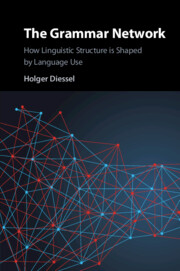Book contents
- The Grammar Network
- The Grammar Network
- Copyright page
- Contents
- Figures
- Tables
- Preface
- Abbreviations
- 1 Introduction
- Part I Foundations
- Part II Signs as Networks
- Part III Filler–Slot Relations
- Part IV Constructional Relations
- 10 Construction Families
- 11 Encoding Asymmetries of Grammatical Categories
- 12 Conclusion
- References
- Author Index
- Subject Index
10 - Construction Families
from Part IV - Constructional Relations
Published online by Cambridge University Press: 12 August 2019
- The Grammar Network
- The Grammar Network
- Copyright page
- Contents
- Figures
- Tables
- Preface
- Abbreviations
- 1 Introduction
- Part I Foundations
- Part II Signs as Networks
- Part III Filler–Slot Relations
- Part IV Constructional Relations
- 10 Construction Families
- 11 Encoding Asymmetries of Grammatical Categories
- 12 Conclusion
- References
- Author Index
- Subject Index
Summary
Every construction has a particular ecological location in the grammar network that is defined by its relationship to other constructions in the system. Since the relationships between constructions are similar to those between lexemes, Chapter 10 begins with a short discussion of psycholinguistic research on the mental lexicon, which is commonly analyzed as an activation network (Dell 1986). There is abundant evidence that lexical access is influenced by several interacting factors including frequency, priming, similarity and neighborhood density, or family size. Considering research on sentences processing, L1 acquisition and language change, the chapter argues that the availability, or accessibility, of constructions is influenced by the same factors as lexical access, that is, by frequency, priming, similarity and neighborhood density, supporting the hypothesis that lexemes and constructions are organized in similar ways. Specifically, the chapter argues that grammar includes “construction families” that influence the use and the development of syntactic patterns (Diessel and Tomasello 2005; Wells et al. 2009).
Keywords
- Type
- Chapter
- Information
- The Grammar NetworkHow Linguistic Structure Is Shaped by Language Use, pp. 199 - 222Publisher: Cambridge University PressPrint publication year: 2019



